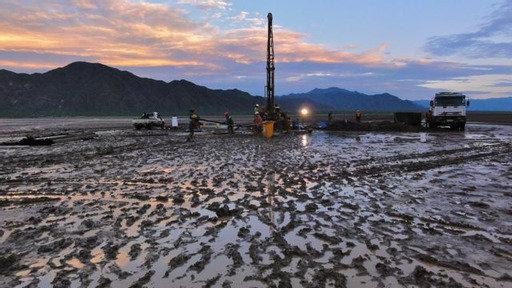Jun 1 2021
Headed by Dr Stefanie Kaboth-Bahr from the University of Potsdam, a scientific consortium has discovered that prehistoric El Niño-like weather patterns were mainly responsible for causing the environmental change in the sub-Saharan African region over the past 620 thousand years—the crucial timeframe for human evolution.
 Today a saline mudflat, the Chew Bahir Basin in southern Ethiopia once held an extensive paleo-lake during humid phases. Scientific deep drilling from the current playa surface produced a ~620,000-year long sedimentary record providing insights into the intense shifts of eastern Africa’s highly variable hydroclimate. Image Credit: © Annett Jungiger, University of Tübingen.
Today a saline mudflat, the Chew Bahir Basin in southern Ethiopia once held an extensive paleo-lake during humid phases. Scientific deep drilling from the current playa surface produced a ~620,000-year long sedimentary record providing insights into the intense shifts of eastern Africa’s highly variable hydroclimate. Image Credit: © Annett Jungiger, University of Tübingen.
The researchers discovered that these prehistoric weather patterns had more significant effects in sub-Saharan Africa when compared to glacial-interglacial cycles that are more commonly associated with the evolution of humans.
It is a well-known fact that climate change was responsible for driving human evolution in Africa, but the actual character of that climate change and its effects are not fully understood.
Glacial-interglacial cycles have a powerful effect on climate change patterns in several areas of the world and they were also believed to control the environmental changes in Africa at the time of the crucial period of the evolution of humans in the last ~1 million years. The changes in the ecosystem fueled by such glacial cycles are assumed to have triggered the evolution and spread of early human species.
An article, which was recently published in the Proceedings of the National Academy of Sciences of the United States of America (PNAS), now challenges this concept.
Dr Kaboth-Bahr and an international team of multidisciplinary colleagues identified prehistoric El Niño-like weather patterns as the main drivers of significant climate changes in Africa. This insight enabled the researchers to re-assess the prevailing climatic framework of the evolution of humans.
Walking with the Rain
To create an in-depth spatial picture of where and when the wet or dry conditions existed across the continent, Dr Kaboth-Bahr and her collaborators incorporated as many as 11 climate archives from throughout Africa spanning the last 620 thousand years.
We were surprised to find a distinct climatic east-west ‘seesaw’ very akin to the pattern produced by the weather phenomena of El Niño, that today profoundly influences precipitation distribution in Africa.
Dr Stefanie Kaboth-Bahr, Study Lead, Max Planck Institute for the Science of Human History
The study authors inferred that the impacts of the tropical Pacific Ocean on the supposed “Walker Circulation”—a belt of convection cells found along the equator and affecting the aridity and rainfall of the tropics—were the main driver of this climate change.
The data evidently demonstrates that the wet and dry areas changed between the west and east of the African continent on timescales of about 100,000 years, and each of these climatic changes was accompanied by significant turnovers in flora and mammal fauna.
This alternation between dry and wet periods appeared to have governed the dispersion and evolution of vegetation as well as mammals in eastern and western Africa. The resultant environmental patchwork was likely to have been a critical component of human evolution and early demography as well.
Dr Stefanie Kaboth-Bahr, Study Lead, Max Planck Institute for the Science of Human History
The researchers further pointed out that while climate change was definitely not the only factor to drive the evolution of early humans, this latest analysis still offers a whole new picture of the close relationship between the origin of early ancestors and environmental changes.
We see many species of pan-African mammals whose distributions match the patterns we identify, and whose evolutionary history seems to articulate with the wet-dry oscillations between eastern and western Africa.
Dr Eleanor Scerri, Study Co-Authors and Evolutionary Archaeologist, Max Planck Institute for the Science of Human History
“These animals preserve the signals of the environments that humans evolved in, and it seems likely that our human ancestors may have been similarly subdivided across Africa as they were subject to the same environmental pressures,” added Dr Scerri.
Ecotones: The Transitional Regions Between Different Ecological Zones
The researchers’ study indicates that a seesaw-like rainfall pattern that alternates between western and eastern Africa perhaps had the impact of producing crucially significant ecotonal regions—the buffer regions between various ecological zones, like forest and grassland.
“Ecotones provided diverse, resource-rich and stable environmental settings thought to have been important to early modern humans. They certainly seem to have been important to other faunal communities,” added Dr Kaboth-Bahr.
The researchers believe that the interior areas of Africa could have been crucially significant for promoting long-term population continuity.
According to Dr Scerri, “We see the archaeological signatures of early members of our species all across Africa, but innovations come and go and are often re-invented, suggesting that our deep population history saw a constant saw-tooth like pattern of local population growth and collapse.”
“Ecotonal regions may have provided areas for longer term population continuity, ensuring that the larger human population kept going, even if local populations often went extinct,” noted Dr Scerri.
“Re-evaluating these patterns of stasis, change and extinction through a new climatic framework will yield new insights into the deep human past. This does not mean that people were helpless in the face of climatic changes but shifting habitat availability would certainly have impacted patterns of demography, and ultimately the genetic exchanges that underpin human evolution,” concluded Dr Kaboth Bahr.